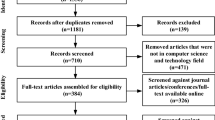Abstract
This paper reviews the use of evolutionary algorithms (EAs) to optimize artificial neural networks (ANNs). First, we briefly introduce the basic principles of artificial neural networks and evolutionary algorithms and, by analyzing the advantages and disadvantages of EAs and ANNs, explain the advantages of using EAs to optimize ANNs. We then provide a brief survey on the basic theories and algorithms for optimizing the weights, optimizing the network architecture and optimizing the learning rules, and discuss recent research from these three aspects. Finally, we speculate on new trends in the development of this area.
Similar content being viewed by others
References
Alvarez A (2002) A neural network with evolutionary neurons. Neural Process Lett 16(1): 43–52
Castillo P, Merelo J, Rivas V et al (2000) G-prop: global optimization of multilayer perceptrons using gas. Neurocomput 35(4): 149–163
Castillo O, Melin P, Kacprzyk J et al (2008) Optimization of artificial neural network architectures for time series prediction using parallel genetic algorithms. Soft Comput Hybrid Intell Syst 154: 387–399
Chen X, Yu S (2003) Improvement on crossover strategy of real-valued genetic algorithm. Acta Electronica Sinica 31(1): 71–74
Fream M (1990) The upstart algorithm: a method for constructing and training feedforward neural networks. Neural Comput 2(2): 198–209
Gao X, Ovaska S, Hartimo Z (1996) Speech signal restoration using an optimal neural network structure. In: Proceedings of the IEEE intenational conference on neural networks, pp 1841–1846
Guo Z (1992) Using genetic algorithms to select inputs for neural networks. In: Proceedings of the IEEE international workshop on combinations of genetic algorithms and neural networks, pp 223–234
Harpham C, Dawson C, Brown M (2004) A review of genetic algorithms applied to training radial basis function networks. Neural Comput Applic 13(3): 193–201
Hertz J, Krogh A (1991) Introduction to the theory of neural computation. Addison-Wesley Press, Boston
Kim H, Jung S, Kim T et al (1996) Fast learning method for back-propagation neural network by evolutionary adaptation of learning rates. Neurocomput 11(1): 101–106
Kitano H (1990) Designing neural networks using genetic algorithms with graph generation system. Complex Syst 4(4): 461–476
Mccllochw S, Pitts W (1943) A logical calculus of the ideas immanent in nervous activity. Bull Math Biophys 10(5): 115–133
Meng X, Zhang H, Tan W (2000) A hybrid method of GA and BP for short-term economic dispatch of hydrothermal power systems. Math Comput Simul 51(3): 341–348
Montana D, Davis L (1989) Training feedforward neural networks using genetic algorithm. In: Proceedings of the 11th international joint conference on artificial intelligence, San Francisco, CA
Murata N, Yoshizawa S, Amari S (1994) Network information criterion—determining the number of hidden units for an artificial neural network model. IEEE Trans Neural Netw 5(6): 865–872
Peter J, Gregory M, Jordan B (1994) An evolutionary algorithm that constructs recurrent neural networks. IEEE Trans Neural Netw 5(2): 54–65
Ren Z, San Z (2007) Improvement of real-valued genetic algorithm and performance study. Acta Electronica Sinica 35(2): 269–274
Roy A, Kim L, Mukhopaduyay S (1993) A polynomial time algorithm for the construction and training of a class of multilayer perceptrons. Neural Netw 6(4): 535–545
Sietsma J, Dow R (1991) Creating artificial neural networks that generalize. Neural Netw 4(1): 67–79
Sutton R (1986) Two problems with backpropagation and other steepest-descent learning procedures for networks. In: Proceedings of 8th annual conference of the cognitive science society, Hillsdale, NJ
Whitley D (2001) An overview of evolutionary algorithm: practical Issues and common pitfalls. Inf Softw Technol 43(14): 817–831
Whitley D, Starkweather T, Bogart C (1990) Genetic algorithms and neural networks: optimizing connection and connectivity. Parallel Comput 14(3): 347–361
Xie J (1997) A brief review on evolutionary computation. Control Decis 12(1): 1–7
Yao X (1993) A review of evolutionary artificial neural networks. Int J Intell Syst 4(3): 203–222
Yao X (1999) Evolving artificial neural networks. Proc IEEE 87: 1423–1447
Yao X, Liu Y, Darwen P (1997) A new evolutionary system for evolving artificial neural networks. IEEE Trans Neural Netw 8(3): 694–713
Yao W, Wan Q, Chen Z, Wang J (2004) The researching overview of evolutionary neural networks. Comput Sci 31(3): 125–129
Yen G (2006) Multi-objective evolutionary algorithm for radial basis function neural network design. Stud Comput Intell 16: 221–239
Zheng Z, Zheng S (2002) Study on a mutation operator in evolving neural networks. J Softw 13(4): 726–731
Author information
Authors and Affiliations
Corresponding author
Rights and permissions
About this article
Cite this article
Ding, S., Li, H., Su, C. et al. Evolutionary artificial neural networks: a review. Artif Intell Rev 39, 251–260 (2013). https://doi.org/10.1007/s10462-011-9270-6
Published:
Issue Date:
DOI: https://doi.org/10.1007/s10462-011-9270-6




